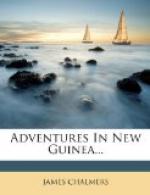The following day, Sunday, the 15th, we held the usual services under a large tree near the mission house; a great many strangers present; the latter were very troublesome. On Monday afternoon the saw was returned. The Mayri left us that day, to visit the teachers at East Cape. The people are getting quieter. At present they are chiefly interested in the sawing of the wood for the flooring of the house. They work willingly for a piece of hoop-iron and a few beads, but cannot do much continuously. They seem to have no kind of worship, and their sports are few. The children swing, bathe, and sail small canoes. The grown-up people have their dance—a very poor sort of thing. A band of youths, with drums, stand close together, and in a most monotonous tone sing whilst they beat the drums. The dancers dance round the men once or twice, and all stop to rest a bit. I have been twice present when only the women danced. They bury their dead, and place houses over the graves, which they fence round, planting crotons, bananas, etc., inside. They do their cooking inside their houses. It was very hot and uncomfortable when we were in the native house. The master being a sort of chief, and having a large household, a great deal of cooking was required. Three large fires were generally burning in their end of the house for the greater part of the day. The heat and smoke from these fires were not nice. Indeed, they generally had one or two burning all night, to serve for blankets, I suppose.
[Natives of South-Eastern New Guinea: 59.jpg]
We went on with our work about the place, getting on well with the natives and with those from other parts. We became so friendly with the natives that I had hoped to go about with them in their canoes. Several natives from one of the settlements invited me to visit their place, and said if I went with them in their canoe they would return me. I went with them, and was well received by all the people at the settlement, where I spent some hours. On the 21st of December, the Mayri returned from East Cape, and reported that all were sick, but that the people were very friendly and kind to teachers. Anxious to keep the vessel employed, and to prepare the way for landing teachers, I resolved to visit a settlement on the mainland at deadly feud with this people. The people here tried hard to dissuade me from going, telling me that, as I stayed with them, my head would be cut off. Seeing me determined to go, they brought skulls, saying, mine would be like that, to adorn their enemies’ war canoe, or hang outside the chief’s house. Feeling sure that they did not wish me to go because they were afraid the hoop-iron, the knives, axes, beads, and cloth might also be distributed on the other side, I told them I must go; so they left me to my fate.




